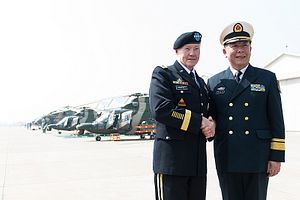Citing a U.S. Department of Defense official, Reuters reports that Chinese and U.S. officials are meeting this week to talk about rules of the road for encounters in the air and at sea. Chinese and U.S. officials will gather at the Pentagon on Wednesday and Thursday for the discussion. According to the unnamed defense official, the working group will talk about “existing multilateral standards of behavior for air and maritime activities.”
The talks, though planned well in advance, will convene only days after the Pentagon complained of a “dangerous intercept” by a Chinese fighter jet of a U.S. P-8 patrol aircraft. According to Defense Department spokesman Admiral John Kirby, the Chinese fighter jet conducted a number of dangerous maneuvers (including a roll) within close proximity to the U.S. aircraft. The Chinese Defense Ministry called the complaint “totally groundless” and blamed the U.S. for conducting “massive and frequent close-in surveillance of China that endanger the two sides’ air and marine security.”
The incident, and the conflicting reports, highlight the urgent need for agreed-upon standards of conduct — both for routine encounters in international airspace and waters, and more generally to set a standard for surveillance missions. A series of dangerous meetings between U.S. and Chinese naval vessels (such as last year’s “Cowpens Incident”) and aircraft have set the scene for a deadly accident.
Indeed, there are disturbing similarities between the August encounter and the 2001 Hainan Incident, where a collision between a U.S. EP-3 intelligence aircraft and a Chinese fighter jet downed both planes, killing the Chinese pilot. Both incidents involved a U.S. surveillance aircraft being intercepted by a Chinese fighter near the island of Hainan — and both, according to the U.S., saw a Chinese pilot engaging in reckless behavior in close proximity to another aircraft. The 2001 incident was bad enough, but political and strategic tensions between the U.S. and China have risen exponentially since then. Should another fatal collision occur today, the ramifications would be enormous.
Given the risks, it’s imperative that the U.S. and China come to an agreement on the “rules of the road” — standards of conduct for encounters between their military forces in international airspace and maritime areas. Even more importantly, though, both sides must first agree upon what constitutes acceptable use of these non-sovereign zones. The U.S. believes that surveillance within another country’s 200 mile exclusive economic zone (but outside the 12 nautical mile zone delineating sovereign territory) is acceptable. China does not recognize U.S. surveillance missions within its EEZ as legitimate military activity (although, confusingly, it appears to claim the right to conduct such surveillance on other countries). Agreeing to standards of conduct (while undoubtedly a positive step) would have little impact on the potential for accidents like the 2001 Hainan Incident unless both sides are actually in agreement on what constitutes “routine” military activities.
Fortunately, there are some existing blueprints for military agreements addressing both standards of conduct and the extent of acceptable surveillance. For example, the Treaty on Open Skies (signed in 1992) explicitly states the signatories’ acceptance of a certain number of “unarmed aerial observation flights” over the participant’s territory. It was originally negotiated between members of NATO and the Warsaw Pact, and was meant as a confidence-building measure between the U.S. and USSR. Currently, the Treaty on Open Skies is restricted to Europe and North America. A similar agreement for Asia, or even just between the U.S. and China, has the potential to greatly reduce tensions resulting from surveillance operations.
In addition, as James Steinberg and Michael O’Hanlon argue in their recent book Reassurance and Resolve: U.S.-China Relations in the Twenty-First Century, old U.S.-USSR agreements on unplanned military encounters (particularly maritime encounters) could also serve as a useful blueprint for governing U.S.-China military interactions. According to Reuters, the U.S. and Chinese militaries have not yet reached the point of negotiating new agreements — rather, they are attempting to come to a shared understanding of existing rules of the road. Even if a shared surveillance agreement remains out of reach, agreeing to standards of conduct would still serve a useful role in reducing tensions. The idea is to prevent needless escalation, and to provide channels of communication in the event of unplanned encounters.
When looking at U.S.-USSR blueprints, however, there are also some discouraging signs. For one thing, many of the most useful agreements were reached not during the height of the Cold War, when tensions were at their greatest, but during the period of détente in the 1980s (and the Treaty on Open Skies, as mentioned above, was signed ever later, in 1992). In other words, successful negotiations came only after years of unbridled hostility — and when the USSR was beginning to fade. That doesn’t bode well for China and the U.S. being able to reach an accord to forestall tension before it gets out of hand.
Second, the U.S.-USSR agreements were made between two militaries of roughly equal capabilities. Agreeing to allow close-in Soviet surveillance thus legitimized the United States’ own surveillance activities and vice versa. China’s military capabilities, however, are largely limited to its own territory and the near seas. China simply doesn’t have the capabilities to conduct routine surveillance close-in to the U.S. coasts — at least, not at nearly the same rate as Washington does to China. Thus, agreeing to allow such surveillance provides nothing to China, as it does not reap the benefits of reciprocity. It will be difficult to convince China to agree to allow the U.S. to conduct surveillance when, in the short-term, China cannot do the same.

































